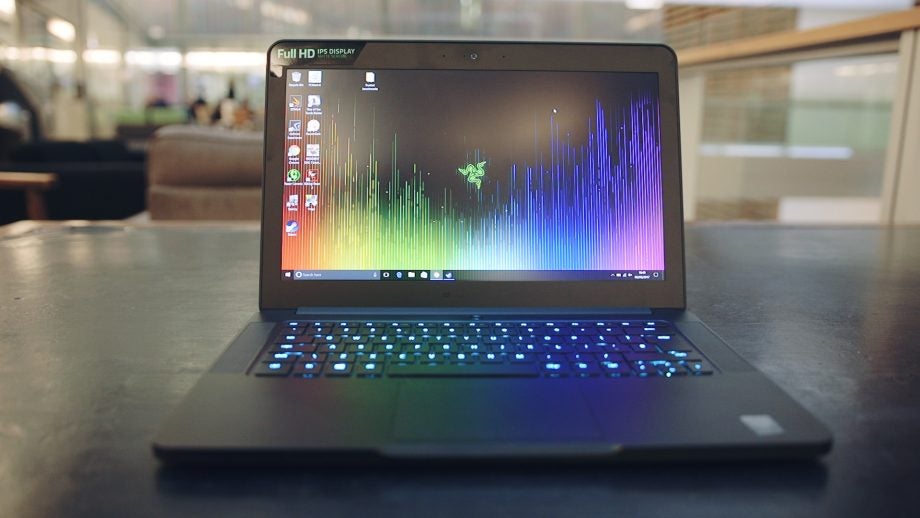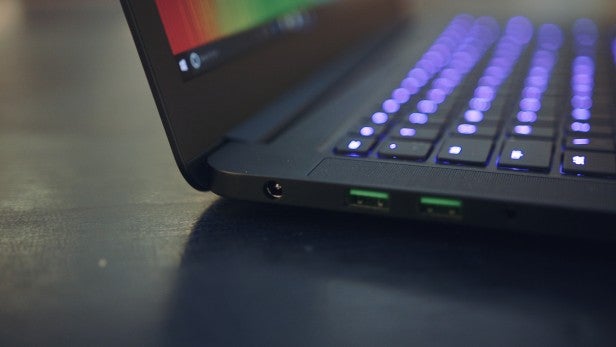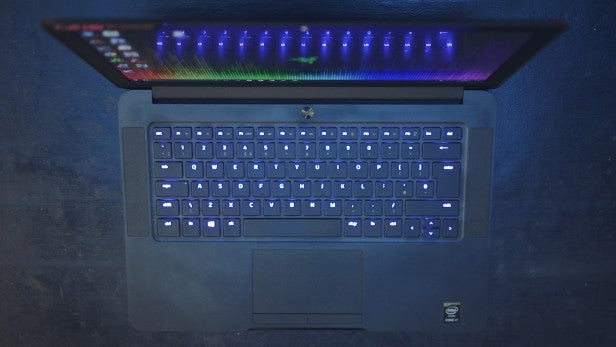Razer Blade Review
Razer Blade
Another excellent thin and light gaming machine

Sections
- Page 1 Razer Blade Review
- Page 2 Performance, battery and conclusion Review
Verdict
Pros
- Lightweight, but robust design
- VR-ready
- Great processor and GPU performance
- RGB keyboard will appeal to some
Cons
- Poor battery life
- Shallow keyboard action
- More expensive than rivals
Key Specifications
- Review Price: £1799.99
- Quad-core 2.6-3.5GHz Intel Core i7-6700HQ
- 16GB DDR4 memory
- 6GB Nvidia GeForce GTX 1060
- 14-inch, Full HD screen (QHD and 4K available)
- 256GB PCIe SSD
- 3x USB 3.0, 1x USB 3.1 Type-C (Thunderbolt 3), HDMI, 3.5mm headset jack
- RGB backlit keyboard
- Weight: 1.95kg
What is the Razer Blade?
Update: read our Razer Blade 15 review.
The Blade is Razer’s attempt to create the ultimate laptop; one that’s small and light, but powerful enough to play games at 1080p as well as edit video. With top-end specs including a Core i7 CPU and Nvidia GeForce GTX 1060 GPU, it’s also VR ready too.
It sits between the company’s lightweight, Razer Blade Stealth Ultrabook and power-house Razer Blade Pro GTX 1080-powered mobile desktop.
Having put it through its paces I can confirm that the Blade delivers on all Razer’s performance and mobility promises, and is an ideal choice for buyers looking for a jack-of-all trades, lightweight laptop that’s capable of 1080p gaming.
However, I’m not fully convinced that the Windows 10-powered MacBook Pro-rival is the right choice for serious PC gamers or casual Ultrabook buyers. There are currently better value options available on the market.
Watch: Razer Blade review
Razer Blade – Design
Design-wise, the 2017 Blade doesn’t stray too far from Razer’s standard template, adopting the same black metal, ultraportable look of the firm’s older laptops. It’s more of a cross between the Aorus X5 and MacBook Pro than a regular gaming laptop.
Some may bemoan the lack of pizzazz that can be seen on the gaming laptops of power players such as Asus, MSI and Gigabyte, but I’m a huge fan of less flamboyant design. The lack of any external RGB lights – save for the glowing green Razer logo on the Blade’s top – gives this laptop an unassuming feel, making it one of the only laptops I’d be comfortable to use when out and about.
Sitting in a coffee shop, I wasn’t on the receiving end of any of the odd stares evident when testing older laptops such as the MSI Dragon MSI GT72S Dragon Edition or Asus ROG GX700.

I’m also amazed at how compact and light the Blade is, by gaming laptop standards. Two years ago, if you’d told me that a laptop with a Core i7 CPU and dedicated, full-fat desktop-class GPU could weigh under 2kg and would be just 17.9mm thick, I’d have lumped that firmly into the ‘fake news’ category.
But all this has changed with the arrival of Nvidia’s latest wave of 10-series ‘Pascal’ cards, and the 1080p version of the Blade I tested is exactly that.
This means the Blade is one of a select few 1060-powered laptops that’s small and light enough to fit into regular satchels and backpacks, and is slight enough to not make a trip across London feel like endurance training. I carried the laptop around the city, using it as my primary work and personal laptop for a week without issue. This has been possible with other laptops such as the Gigabyte Aero 14 and MSI GS43VR Phantom Pro too – but for me, the Blade’s compact nature is impressive nonetheless.
Razer has also managed to tick all the right boxes when it comes to connectivity. Around its right and left sides you’ll find three USB 3 ports, a single Thunderbolt 3 (USB Type-C) connector, plus an HDMI 2 and headphone jack input.
The combination of ports means the Blade will be able to connect to most modern screens and has adequate USBs to comfortably connect to a VR headset, such as the Oculus Rift.
Related: Best GPUs

Be warned, though: the Blade’s light weight will be an issue when it comes to VR gaming. On a few occasions I nearly sent the Blade flying across my lounge while fleeing a zombie or dodging a bullet in virtual reality, after getting the cables caught.
My only concerns with the Blade’s build quality and design stem from its hybrid nature. With the Blade it’s clear that Razer has tried to create an all-in-one device that will appeal to gamers and basic Ultrabook buyers. This sounds great, but the end result is that a few compromises have been made on both sides.
Compared to the Dell XPS 15 or MacBook Pro, the Blade still feels a little chunky and unrefined. Its screen is surrounded by a giant bezel, which looks distinctly retro compared to the XPS 15’s Infinity Display. The Blade’s black metal chassis also doesn’t feel anywhere near as luxurious as that of the MacBook, and is a magnet for scratches and fingerprints.
Razer Blade – Keyboard and trackpad
The Blade’s trackpad and keyboard designs are also a mixed bag. The trackpad is suitably large and has decent physical left and right keys, but out of the box it feels a little sluggish compared to competing Ultrabooks, such as the Dell XPS 15 which features a Microsoft Precision-certified touchpad.
Tweaking the settings improves the touchpad’s responsiveness, however, and in general it’s more than good enough for everyday use.
The chiclet keyboard is well spread out and comfortable to type on, although the shallow key action isn’t ideal for gaming. The fact that the keyboard has programmable RGB backlights will appeal to some gamers; for me it was more an annoyance, and I soon locked it to one colour.
My only real criticism of the keyboard is the lack of macro keys. Considering the Blade’s status as a gaming laptop, the absence of macro keys is frustrating, especially when playing action RPGs and MOBAs.
Related: Best gaming laptops
Razer Blade – Display
The Blade is available in Full HD, QHD+ and 4K screen options. I tested the basic Full HD option, which is the configuration I’d recommend that most people buy; playing games above 1080p on a display of this size, in my opinion, isn’t worth the extra money.
The 14-inch IPS matte display tested well during TrustedReviews’ screen tests. The 311-nits white level means whites appear clean and bright. The 0.31-nits black level isn’t the deepest I’ve seen, but adds up to give the Blade an decent1,013:1 contrast ratio.
The 7,167K colour temperature is a little cooler than the 6,500K ideal, but not a marked enough departure that many will notice.
In real-world use, games universally looked decent. Colours were rich, and even in moody games where lighting is important – Resident Evil 7, for example – they didn’t look washed out, despite the fairly average black level.
Artists, whose work relies on accurate colours, will be disappointed with the screen’s 84.5% sRGB and 61.8% Adobe RGB coverage, but outside of the MacBook Pro and 4K Dell XPS 15, you’re unlikely to find a machine with significantly better numbers.
How we test laptops
Unlike other sites, we test every laptop we review thoroughly over an extended period of time. We use industry standard tests to compare features properly. We’ll always tell you what we find. We never, ever, accept money to review a product.



